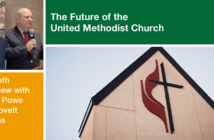It is commonplace to hear references to what it means for churches to function in “the current financial recession.” But there is another recession going on in the United States that has been affecting churches far longer and more consistently than the economic downturn. It is the worship recession.
Figures collected by the Lewis Center for Church Leadership from four denominations show how relatively strong attendance was in the closing years of the last decade compared to the opening years of this decade.
Often economic downturns come after a rise in economic fortunes that lulls people into thinking that the good times will continue. Similarly, the current worship recession in many churches does come after something of a mini-boom in attendance. As I explained in my article “No Shows” in the current issue of Christian Century, many people assume that there has been a steady decline in worship attendance for all the mainline denominations since the mid-1960s — the era when most of them began to see their memberships decline. But trends in attendance — usually thought to be a better indicator of church vitality than trends in membership — have actually followed their own patterns.
Figures below collected by the Lewis Center for Church Leadership from four denominations show how relatively strong attendance was in the closing years of the last decade compared to the opening years of this decade.
| 1994-2000 | 2001-2008 | |
| Episcopal Church | +3.39% | -17.86% |
| United Methodist Church | +2.53% | -10.22% |
| Evangelical Lutheran Church in America | -0.58% | -15.41% |
| Presbyterian Church (U.S.A.) | -2.76% | -15.62% |
| Average | +2.58% | -14.78% |
Keep in mind that the downturn since 2001 is not because the 2001 attendance figures spiked so high. They did not. Where there were gains in 2001, they were relatively modest. People in the United States flocked to houses of worship in unusually high numbers following the September 11, 2001, attacks. While not all denominations showed an annual attendance increase in 2001 as a result, many did. Some say this attendance surge lasted about five weeks. However long it was, it did not result in long-term attendance gains. The opposite has actually happened among many denominations, including the traditional mainline denominations.
For more information see: Lovett H. Weems, Jr. “No shows: The decline in worship attendance”, Christian Century, September 22, 2010.






